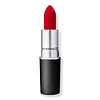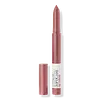What's inside
What's inside
 Key Ingredients
Key Ingredients

 Benefits
Benefits

 Concerns
Concerns

 Ingredients Side-by-side
Ingredients Side-by-side

Dimethicone
EmollientIsoeicosane
EmollientKaolin
AbrasiveCeresin
Emulsion StabilisingParaffin
PerfumingIsononyl Isononanoate
EmollientMicrocrystalline Wax
Emulsion StabilisingSilica
AbrasiveCaprylic/Capric Triglyceride
MaskingCopernicia Cerifera Wax
Hydrogenated Polyisobutene
EmollientVanillin
MaskingTocopherol
AntioxidantGlyceryl Linoleate
EmollientGlyceryl Linolenate
EmollientPvp
Emulsion StabilisingMethicone
EmollientTriethoxycaprylylsilane
Mica
Cosmetic ColorantCI 77891
Cosmetic ColorantIron Oxides
CI 77163
Cosmetic ColorantCI 75470
Cosmetic ColorantCI 15850
Cosmetic ColorantCI 45410
Cosmetic ColorantCI 19140
Cosmetic ColorantCI 15985
Cosmetic ColorantCI 47005
Cosmetic ColorantCI 17200
Cosmetic ColorantCI 42090
Cosmetic ColorantCI 73360
Cosmetic ColorantCI 45370
Cosmetic ColorantDimethicone, Isoeicosane, Kaolin, Ceresin, Paraffin, Isononyl Isononanoate, Microcrystalline Wax, Silica, Caprylic/Capric Triglyceride, Copernicia Cerifera Wax, Hydrogenated Polyisobutene, Vanillin, Tocopherol, Glyceryl Linoleate, Glyceryl Linolenate, Pvp, Methicone, Triethoxycaprylylsilane, Mica, CI 77891, Iron Oxides, CI 77163, CI 75470, CI 15850, CI 45410, CI 19140, CI 15985, CI 47005, CI 17200, CI 42090, CI 73360, CI 45370
Isododecane
EmollientPolyethylene
AbrasiveTrimethylsiloxyphenyl Dimethicone
Isohexadecane
EmollientDimethicone
EmollientAcrylates/Dimethicone Copolymer
Skin ConditioningPolypropylsilsesquioxane
Stearyl Heptanoate
EmollientHydrogenated Polyisobutene
EmollientHydrogenated Styrene/Methylstyrene/Indene Copolymer
Alumina
AbrasiveSynthetic Fluorphlogopite
Calcium Aluminum Borosilicate
Limonene
PerfumingCalcium Sodium Borosilicate
Aluminum Hydroxide
EmollientPolybutylene Terephthalate
Silica
AbrasiveMagnesium Silicate
AbsorbentSilica Silylate
EmollientEthylene/Va Copolymer
Emulsion StabilisingAcrylates Copolymer
Pentaerythrityl Tetra-Di-T-Butyl Hydroxyhydrocinnamate
AntioxidantBenzyl Benzoate
AntimicrobialTin Oxide
AbrasiveBenzyl Alcohol
PerfumingCitronellol
PerfumingLinalool
PerfumingGeraniol
PerfumingDisodium Stearoyl Glutamate
CleansingTocopherol
AntioxidantParfum
MaskingCI 77891
Cosmetic ColorantCI 77491
Cosmetic ColorantCI 77492
Cosmetic ColorantCI 77499
Cosmetic ColorantCI 45410
Cosmetic ColorantCI 15850
Cosmetic ColorantCI 45380
Cosmetic ColorantMica
Cosmetic ColorantCI 15985
Cosmetic ColorantCI 19140
Cosmetic ColorantCI 77163
Cosmetic ColorantCI 17200
Cosmetic ColorantCI 42090
Cosmetic ColorantCI 75470
Cosmetic ColorantIsododecane, Polyethylene, Trimethylsiloxyphenyl Dimethicone, Isohexadecane, Dimethicone, Acrylates/Dimethicone Copolymer, Polypropylsilsesquioxane, Stearyl Heptanoate, Hydrogenated Polyisobutene, Hydrogenated Styrene/Methylstyrene/Indene Copolymer, Alumina, Synthetic Fluorphlogopite, Calcium Aluminum Borosilicate, Limonene, Calcium Sodium Borosilicate, Aluminum Hydroxide, Polybutylene Terephthalate, Silica, Magnesium Silicate, Silica Silylate, Ethylene/Va Copolymer, Acrylates Copolymer, Pentaerythrityl Tetra-Di-T-Butyl Hydroxyhydrocinnamate, Benzyl Benzoate, Tin Oxide, Benzyl Alcohol, Citronellol, Linalool, Geraniol, Disodium Stearoyl Glutamate, Tocopherol, Parfum, CI 77891, CI 77491, CI 77492, CI 77499, CI 45410, CI 15850, CI 45380, Mica, CI 15985, CI 19140, CI 77163, CI 17200, CI 42090, CI 75470
 Reviews
Reviews

Ingredients Explained
These ingredients are found in both products.
Ingredients higher up in an ingredient list are typically present in a larger amount.
Ci 15850 is the pigment color red. It is an azo dye and created synthetically.
Azo dyes need to be thoroughly purified before use. This allows them to be more stable and longer-lasting.
This ingredient is common in foundations, lipsticks, and blushes. This color is described as brown/orangey red.
It has many secondary names such as Red 6 and Red 7. According to a manufacturer, Red 6 usually contains aluminum.
Learn more about CI 15850Ci 15985 is a dye made from petroleum. It is synthetically created and approved by the FDA for use in foods and cosmetics.
The color of this dye is orange/yellow.
This ingredient can be found in makeup, sun care, and skincare.
Learn more about CI 15985Ci 17200 is a synthetic reddish-purple dye.
CI 19140 is also known as Tartrazine. Tartrazine is a synthetic dye used in cosmetics, foods, and medicine to add a yellow color.
Tartrazine is created from petroleum and is water-soluble.
Some people may experience allergies from this dye, especially asthmatics and those with an aspirin intolerance.
Learn more about CI 19140Ci 42090 is a synthetic dye created from petroleum. It is used to give a bright blue color to cosmetics, medicine, and food.
CI 45410 is a synthetic red-pigment and dye.
It often goes by both Red 28 or Red 27; manufacturers label both ingredients as CI 45410.
This dye is commonly found in makeup because it imparts a vivid color. Some types of this dye change color based on pH level and interaction with moisture:
Your skin has a natural pH of around 4.5 - 5.5.
According to the FDA, CI 45410 is not permitted for use in eye products.
Red 27 is a flourescein dye and commonly used as a fluorescent tracer in medicine.
Learn more about CI 45410Ci 75470 is a bright-red pigment. It is AKA carmine.
Carmine is derived from insects such as the cochineal beetle. This ingredient has been used as a natural dye for over 2000 years.
This synthetic powder is used to add a pearly/white color in cosmetics.
Ci 77891 is a white pigment from Titanium dioxide. It is naturally found in minerals such as rutile and ilmenite.
It's main function is to add a white color to cosmetics. It can also be mixed with other colors to create different shades.
Ci 77891 is commonly found in sunscreens due to its ability to block UV rays.
Learn more about CI 77891Dimethicone is a type of synthetic silicone created from natural materials such as quartz.
What it does:
Dimethicone comes in different viscosities:
Depending on the viscosity, dimethicone has different properties.
Ingredients lists don't always show which type is used, so we recommend reaching out to the brand if you have questions about the viscosity.
This ingredient is unlikely to cause irritation because it does not get absorbed into skin. However, people with silicone allergies should be careful about using this ingredient.
Note: Dimethicone may contribute to pilling. This is because it is not oil or water soluble, so pilling may occur when layered with products. When mixed with heavy oils in a formula, the outcome is also quite greasy.
Learn more about DimethiconeHydrogenated Polyisobutene is a synthetic polymer. Polymers are compounds with high molecular weight. Hydrogenated Polyisobutene is an emollient and texture enhancer.
In one study, Hydrogenated Polyisobutene showed better skin hydration levels than Caprylic/Capric Triglyceride. As an emollient, it helps keep your skin soft and hydrated by trapping moisture in.
Hydrogenated Polyisobutene is often used as a mineral oil replacement.
Learn more about Hydrogenated PolyisobuteneMica is a naturally occurring mineral used to add shimmer and color in cosmetics. It can also help improve the texture of a product or give it an opaque, white/silver color.
Serecite is the name for very fine but ragged grains of mica.
This ingredient is often coated with metal oxides like titanium dioxide. Trace amounts of heavy metals may be found in mica, but these metals are not harmful in our personal products.
Mica has been used since prehistoric times throughout the world. Ancient Egyptian, Indian, Greek, Roman, Aztec, and Chinese civilizations have used mica.
Learn more about MicaSilica, also known as silicon dioxide, is a naturally occurring mineral. It is used as a fine, spherical, and porous powder in cosmetics.
Though it has exfoliant properties, the function of silica varies depending on the product.
The unique structure of silica enhances the spreadability and adds smoothness, making it a great texture enhancer.
It is also used as an active carrier, emulsifier, and mattifier due to its ability to absorb excess oil.
In some products, tiny microneedles called spicules are made from silica or hydrolyzed sponge. When you rub them in, they lightly polish away dead skin layers and enhance the penetration of active ingredients.
Learn more about SilicaTocopherol (also known as Vitamin E) is a common antioxidant used to help protect the skin from free-radicals and strengthen the skin barrier. It's also fat soluble - this means our skin is great at absorbing it.
Vitamin E also helps keep your natural skin lipids healthy. Your lipid skin barrier naturally consists of lipids, ceramides, and fatty acids. Vitamin E offers extra protection for your skin’s lipid barrier, keeping your skin healthy and nourished.
Another benefit is a bit of UV protection. Vitamin E helps reduce the damage caused by UVB rays. (It should not replace your sunscreen). Combining it with Vitamin C can decrease sunburned cells and hyperpigmentation after UV exposure.
You might have noticed Vitamin E + C often paired together. This is because it is great at stabilizing Vitamin C. Using the two together helps increase the effectiveness of both ingredients.
There are often claims that Vitamin E can reduce/prevent scarring, but these claims haven't been confirmed by scientific research.
Learn more about Tocopherol